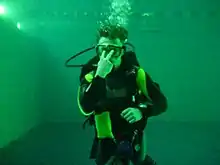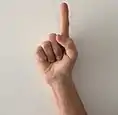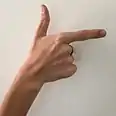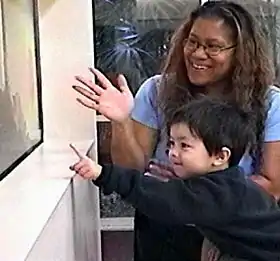Pointing
Pointing is a gesture specifying a direction from a person's body, usually indicating a location, person, event, thing or idea. It typically is formed by extending the arm, hand, and index finger, although it may be functionally similar to other hand gestures. Types of pointing may be subdivided according to the intention of the person, as well as by the linguistic function it serves.

Pointing typically develops within the first two years of life in humans, and plays an important role in language development and reading in children. It is central to the use of sign language, with a large number of signs being some variation on pointing. The nature of pointing may differ for children who have autism or who are deaf, and may also vary by gender. It is typically not observed in children who are blind from birth.
Pointing may vary substantially across cultures, with some having many distinct types of pointing, both with regard to the physical gestures employed and their interpretation. Pointing, especially at other people, may be considered inappropriate or rude in certain contexts and in many cultures. It is generally regarded as a species-specific human feature that does not normally occur in other primates in the wild. It has been observed in animals in captivity; however, there is disagreement on the nature of this non-human pointing.
Definition and types

The primary purpose of pointing is to indicate a direction, location, event or thing relative to a person.[2][lower-alpha 1][3] Pointing is typically defined as having either three or four essential elements:
- Extension of the index finger;
- Flexing the remaining fingers into the palm, possibly with the thumb to the side;
- Usually, but not always, the pronation of the palm to face downward, or to face the mid-line of the body; and
- Extension of the arm.[2][4]
Gestures that do not meet these three or four criteria are usually classified as a "reach" or an “indicative gesture”, although there is no clear consensus on how to differentiate between the two. Additionally, there may be little or no behavioral or functional difference depending on whether a gesture is considered to be pointing, reaching, or otherwise indicative, and reaching may be considered a form of whole-hand pointing.[4] In one review, 11 separate definitions were identified for the related motions of reach, reaching-out, reaching, indicating, and indicates.[4]
Imperative, declarative and interrogative pointing
Types of pointing are traditionally further divided by purpose, between imperative and declarative pointing.[5] Imperative pointing is pointing to make a request for an object, while declarative pointing is pointing to declare, to comment on an object. As Kovacs and colleagues phrases it, "'Give that to me' vs. 'I like that'".[6] This division is similar to that made by Harris and Butterworth between "giving" and "communicative" pointing.[7]:157–8 Determining the intention of pointing in infants is done by considering three factors:
- Whether the behavior is direct toward another,
- Whether it includes "visual-orientation behaviors" such as observing the recipient of the pointing in addition to the object pointed to, and
- Whether the gesture is repeated if it fails to achieve the intended effect on the recipient.[8]
Declarative pointing may further be divided into declarative expressive pointing, to express feelings about a thing, and declarative interrogative pointing, to seek information about a thing.[8] However, according to Kovacs and colleagues interrogative pointing is clearly different from declarative pointing, since its function is to gain new information about a referent to learn from a knowledgeable addressee.[6] Therefore, unlike declarative pointing, interrogative pointing implies an asymmetric epistemic relation between communicative partners.
Linguistic function
Types of communicative pointing may be divided by linguistic function into three main groups:[9]:43
- Objective pointing - pointing to an object within the visual field of both the pointer and the receiver, such as pointing to a chair which is physically present[lower-alpha 2]
- Syntactic or anaphoric pointing - pointing to linguistic entities or expressions previously identified, such as pointing to the chair which is not physically present[lower-alpha 3]
- Imaginative pointing - pointing to things that exist in the imagination, such as pointing to a fictional or remembered chair[lower-alpha 4]
Additionally, pointing in children who are deaf may be divided between diectic or "natural" pointing, which is shared with hearing children, and symbolic pointing used specifically in sign language, learned by observing and imitating others who sign.[11]:34
Development
Pointing is the first communicative gesture that develops in human infants.[12] It is not clear to what extent the behavior may first emerge as a form of meaningless ritualization,[lower-alpha 5] whether some infants may comprehend and visually follow the pointing of others without yet pointing themselves, or whether pointing begins as a form of meaningful imitation, where an infant learns they can produce the same effect in adults as adult produce in them, by mimicking the action of pointing, and drawing attention to an object.[11]:33–4
Pointing generally emerges within the first two years of life, weeks prior to a baby's first spoken word, and plays a central role in language acquisition.[2][lower-alpha 6][13]:352 The onset of pointing behavior is typically between seven and 15 months-of-age, with an average of between 11 months and one year.[13]:353 By eight months, parents reported that 33% of babies exhibited pointing behaviors, with pointing to nearby objects usually occurring by 11 months, and pointing to more distant object by 13 months.[2] By one year of age, more than half of children will exhibit pointing behavior.[4]
As early as 10 months-of-age, children have been shown to spend more time being attentive to novel objects when they are pointed to by others, when compared to objects that are merely presented to them. This time is increased if the object is also labelled verbally. Pointing by children is associated with a high rate of verbal response from adults, specifically labeling the object pointed to.[7]:129 This interaction allows the child to check for words labeling object they do not yet know, and, when combined with declarative verbal statements on the part of the child, may allow them verify the accuracy of words they have already learned.[14]:62
Infants may begin to point in situations where no one else is present, as a form of egocentric expression, termed "pointing-for-self". This is differentiated from "pointing-for-others" which is done while looking at a "recipient" of the pointing, and done as a communicative gesture.[13]:353–4 Kita specifies this variety of pointing in the context of being a deictic gesture, which is done for the benefit of an audience, as distinct from what are deemed "superficially similar behaviors".[2] Demonstrating this, as they mature infants will first point at an object, and then visually verify whether the recipient is being attentive to the object, and by 15 months-of-age, will first verify that they have the attention of the recipient, and only then point as a means of redirecting that attention.[7]:157
Children are more likely to point for adults who respond positively to the gesture. At 16 months they are less likely to point for adults who are shown to be unreliable, adults who have mislabeled objects the children already know the correct word for.[lower-alpha 7] At two years-of-age, children have been shown to be more likely to point for adults than for children their own age.[6]
Relationship with language
.jpg.webp)
A meta-analysis by Colonnesi and colleagues found a strong relationship between pointing and language, including between pointing at an early age and language ability in later life, and pointing at an early age as a predictor of two-word vocal combinations. They concluded that only a "few studies" had not found a strong correlation between pointing and the development of language.[13]:354 Research has also shown that the frequency of communicative pointing from ages 9 months to 12.5 months was positively correlated with vocabulary size for children at age two.[15][lower-alpha 8] The relationship between language development and pointing tends to be stronger in studies which examined declarative pointing specifically or pointing generally, rather than imperative pointing.[13]:355, 361
In school age children, finger-pointing-reading (reading while pointing to words or letters as they are spoken) can play an important role in reading development, by helping to emphasize the association between the spoken and printed word, and encouraging children to be attentive to the meaning of text.[16]:36–7
Deaf speakers of sign language
Pointing plays an important role in sign language, which as much as 25% of signs being a variation of pointing.[2][lower-alpha 9] Children who are deaf have been shown to begin pointing at a similar age to non-deaf children, but this did not confer any advantage in the acquisition of pronouns in American Sign Language.[13]:353–4
Initial observations give some indication that deaf children acquiring the use of American Sign Language (ASL) may exhibit self-pointing behavior earlier than hearing children who are acquiring speech.[17] Pointing to a location begins being deictic for deaf children and hearing alike, but becomes lexicalized for more mature signers. There is a distinction between linguistic pointing in ASL and gestural pointing by deaf users, the latter being identical for deaf and hearing people.[18]
One small-scale study found that the errors in pointing behavior produced by autistic deaf children and autistic hearing children were similar.[19] Both deaf and hearing children use pointing abundantly while learning language, and initially for the same reason, although that starts to diverge as deaf children acquire signs. Pre-verbal hearing infants use pointing extensively, and use a combination of one word plus one gesture (mostly pointing) before they can produce a two-word sentence. Another study looked at deaf Japanese infants acquiring language from ages four months to two years, and found that the infants moved from duos (where a point plus an iconic sign referred to the same thing) to two-sign combinations where they referred to two different things. As they grew, the latter grew more frequent and led to the development of two-sign sentences in Japanese Sign Language.[20]
Those with autism
Children with autism show marked differences compared to others, and greater difficulty in their ability to interpret pointing as a form of communication, and a sign of "something interesting". This is similar to difficulties they may experience with other deictic communication, which depend on an interpretation of the relationship between speaker and listener or on particular spatial references.[7]:159 A lack of declarative or proto-declarative pointing and the inability to follow a point are important diagnostic criteria for children with autism, and have been incorporated into screening tools such as the Modified Checklist for Autism in Toddlers.[11]:34[21]
Other factors
Pointing is dependent on vision, and is not observed in children who are blind from birth.[2] A number of differences have been observed regarding the onset of pointing behavior and gender, and the tendency to point using the right or left hand, with girls being more likely to point up to 15 degrees into the left visual periphery using their right hand, and being ambidextrous further to the left, while boys are typically ambidextrous for 15 degrees to the left and right of center.[2]
Cultural variations

The gestures used for pointing and their interpretation vary among different cultures.[22][23] While studies have observed index finger pointing in infants across a range of cultures, because those studied are also ones where adults frequently use this type of pointing, further study is needed to determine whether these are examples of imitation of behaviors performed by observed adults, or whether it indicates pointing may be biologically determined.[2][lower-alpha 10]
In much of the world, pointing with the index finger is considered rude or disrespectful, especially pointing to a person.[24] Pointing with the left hand is taboo in some cultures.[25] Pointing with an open hand is considered more polite or respectful in some contexts.[26]:51 In Nicaragua, pointing is frequently done with the lips in a "kiss shape" directed towards the object of attention.
Different cultures may point using a range of variations on index finger pointing. In Japan, pointing is done with the fingers together and the palm facing upwards; in Germany, with the little finger only.[27][28][29] Those of Indian heritage may point using the chin, whole hand, or thumb. They may consider index finger pointing rude, but further distinguish a point using two fingers for use only at someone considered inferior.[30]:12 In those living near the Vaupés River, Dixon noted at least three distinct types of pointing:
pointing with the lips for "visible and near" ... pointing with the lips plus a backwards tilt of the head for "visible and not near" ... pointing with the index finger for "not visible" (if the direction in which the object lies is known)[25]:69
Alternatively, among Aboriginal Australian speakers of Arrernte, researchers identified six distinct types of pointing: index finger, open hand palm down, open hand palm vertical, "'horn-hand' pointing (with the thumb, the index finger and the pinkie extended)", pointing with a protruded lip, and pointing with the eye.[25]:69
When pointing to indicate position-in-time, many, but not all cultures tend to point toward the front to indicate events in the future, and toward the back to indicate events in the past. One noted exception is that of speakers of Aymara, who instead tend to associate what is in the past, what is known, with what is in the front, what is seen, and vice versa.[25]:71
In non-human animals
There is some disagreement as to the nature of pointing behaviors in non-human animals. Miklósi and Soproni described pointing as a "species specific, human communicative gesture" not regularly used by any other species of primates living in the wild.[31]:82 Kita concluded similarly that "on the evidence to date only humans use the pointing gesture declarative to share attention with conspecifics."[2] Kovács and colleagues state "pointing as a referential communicative act seems to be unique to human behavior."[6][lower-alpha 11]
However, Leavens and Hopkins note that pointing behavior has been observed in captivity for a range of species. In some, such as apes, the majority of such behavior is spontaneous (meaning without explicit training to do so), but occurs only rarely in others, such as monkeys.[4] When present, this may be accompanied by visual monitoring of the person being interacted with, the audience of their gesture, rather than being attentive only to the object pointed at.[4] Moreover, it seems that non-human great apes also take the perspective of the communicative partner in order to produce clear, unambiguous points.[32]Others have questioned whether this constitutes "true pointing",[14]:71 and whether non-humans have the social or cognitive abilities to understand the intentional communicative nature of pointing.[33]:124
In contrast to the production of pointing, some non-human animal species can appropriately respond to pointing gestures, preferring an object or direction, which was previously indicated by the gesture. Cats,[34] elephants,[35] ferrets,[36] horses[37] and seals[38] can follow the pointing gesture of a human above chance, while dogs can rely on different types of human points[39] and their performance is comparable to that of 2-year-old toddlers in a similar task.[40] However, it seems, that the default function of pointing is different in dogs and humans, because pointing actions refer to particular locations or directions for dogs[41] in an imperative manner, while these gestures usually indicate specific objects in humans to ask for new information or to comment on an object.[6]
See also
- Deixis, words and phrases that cannot be fully understood without additional contextual information
- Joint attention, shared focus of two people on an object, resulting from pointing or other cues
- List of gestures used in non-verbal communication
- Ostensive definition, conveys the meaning of a term by pointing out examples
- Pointing breed, dogs trained to find and indicate the direction of game
- Pointing device, an input interface for inputting spatial data into a computer
- Semiotics, the study of meaning-making, sign process, and meaningful communication
- Sign (semiotics), something that communicates a meaning that is not the sign itself
Notes
- "The prototypical pointing gesture is a communicative body movement that projects a vector from a body part. This vector indicates a certain direction, location or object."[2]
- "deixis ad oculos et aures", or "referent in the domain of common accessibility of speaker and hearer"[10]:226
- "to something which is to be looked for and found in places of speech"[10]:226
- "deixis at the phantasma" ... "situations of recollection and imagination similar to perception"[10]:226
- For example, if an infant receives positive interaction when pointing, they may begin to point as a means of gaining positive interaction itself, and not as a means of intentional communication.[11]:33
- "Pointing emerges out of its antecedent behaviors, such as undirected extension of the index finger, several weeks before the first spoken word."[2]
- For example, labeling a cat as a ball, citing Begus K, Southgate V. Infant pointing serves an interrogative function. Developmental Science. 2012;15:611–617.[6]
- This was true for both users of sign language and spoken word.[15]
- "...pointing is ubiquitous in our day-to-day interactions with others. ...Even when we talk about the referents that are distance in space and time, we often point to the seemingly empty space in front of us. ...'every four signs in signed discourse is a pointing sign'"[2]
- "Is infants' index-finger pointing a biologically programmed choice? ... A more conclusive answer to these questions requires a future study ... in a culture where adults do not use index-finger pointing at all or do so only rarely."[2]
- Referencing Tomasello M. Why We Collaborate? MIT Press; Cambridge: 2009.[6]
References
- "Minimum Course Content for Common Hand Signals for Scuba Diving" (PDF). Recreational Scuba Training Council, Inc. (RSTC) (Jacksonville, FL., USA). 1 December 2005. Retrieved 3 July 2016.
- Kita S (Jun 20, 2003). Pointing: Where Language, Culture, and Cognition Meet. Psychology Press. ISBN 9780805840148. Retrieved 16 January 2018.
- Colletta, Jean-Marc; Guidetti, Michèle (Jun 13, 2012). Gesture and Multimodal Development. John Benjamins Publishing. ISBN 9789027202581. Retrieved 16 January 2018.
- Leavens DA, Hopkins WD (December 1999). "The whole-hand point: the structure and function of pointing from a comparative perspective". Journal of Comparative Psychology. 113 (4): 417–25. doi:10.1037/0735-7036.113.4.417. PMC 2080771. PMID 10608565.
- Bates, Elizabeth; Camaioni, Luigia; Volterra, Virginia (1975). "The acquisition of performatives prior to speech". Merrill-Palmer Quarterly. 21: 205–226 – via JSTOR.
- Kovács, Ágnes M.; Tauzin, Tibor; Téglás, Ernő; Gergely, György; Csibra, Gergely (November 1, 2014). "Pointing as Epistemic Request: 12-month-olds Point to Receive New Information". Infancy. 19 (6): 543–57. doi:10.1111/infa.12060. PMC 4641318. PMID 26568703.
- Harris M, Butterworth G (Dec 6, 2012). Developmental Psychology: A Student's Handbook. Psychology Press. ISBN 9781841691923. Retrieved 16 January 2018.
- Cochet, Hélène; Vauclair, Jacques (2010). "Pointing gesture in young children: Hand preference and language development" (PDF). Gesture. 10 (2–3): 129–149. doi:10.1075/gest.10.2-3.02coc. Retrieved 18 January 2018.
- Weissenborn, Jürgen; Klein, Wolfgang (Jan 1, 1982). Here and There: Cross-linguistic Studies on Deixis and Demonstration. John Benjamins Publishing Company. ISBN 9789027225191. Retrieved 18 January 2018.
- Lenz, Friedrich (Apr 17, 2003). Deictic Conceptualisation of Space, Time and Person. John Benjamins Publishing Company. ISBN 9789027253545. Retrieved 18 January 2018.
- Tomasello, Michael (Jun 30, 2009). Constructing a Language. Harvard University Press. ISBN 9780674017641. Retrieved 24 January 2018.
- "Pointing is infants' first communicative gesture". Science Daily. 24 February 2014. Retrieved 16 January 2018.
- Colonnesi C, Geert JJ, Koster I, Noomb MJ (December 2010). "The relation between pointing and language development: A meta-analysis" (PDF). Developmental Review. 30 (4): 352–366. doi:10.1016/j.dr.2010.10.001.
- Bejarano, Teresa (2011). Becoming Human: From Pointing Gestures to Syntax. John Benjamins Publishing. ISBN 9789027252173. Retrieved 16 January 2018.
- Butterworth G (Jan 2, 2014). Principles of Developmental Psychology: An Introduction. Psychology Press. ISBN 9780863772801. Retrieved 16 January 2018.
- Center, Yola (Oct 21, 2005). Beginning Reading: A Balanced Approach to Teaching Reading During the First Three Years at School. A&C Black. ISBN 9780826488756. Retrieved 24 January 2018.
- Slobin, Dan Isaac (5 July 2017) [1st pub. 1985 Lawrence Erlbaum Associates]. The Crosslinguistic Study of Language Acquisition: Volume 1: the Data. Taylor & Francis. p. 980. ISBN 978-1-317-76885-2. OCLC 994006126. Retrieved 17 January 2018.
- Marschark, Marc (1997). Psychological Development of Deaf Children. New York: Oxford University Press. pp. 84–85. ISBN 978-0-19-511575-8. OCLC 948981235. Retrieved 17 January 2018.
- Quinto-Pozos, David (29 January 2014). Multilingual Aspects of Signed Language Communication and Disorder. Communication disorders across languages. Bristol, U.K.: Multilingual Matters. p. 101. ISBN 978-1-78309-130-0. OCLC 862092449. Retrieved 17 January 2018.
- Torigoe, Takashi (31 August 2006). "19. Japanese Sign Language". In Nakayama, Mineharu; Mazuka, Reiko; Shirai, Yasuhiro (eds.). The Handbook of East Asian Psycholinguistics: Volume 2, Japanese. 2. Cambridge University Press. pp. 142–143. ISBN 978-1-139-45597-8. Retrieved 17 January 2018.
- Handbook of Autism and Pervasive Developmental Disorders, Assessment, Interventions, and Policy. John Wiley & Sons; 2014 [Retrieved 24 January 2018]. ISBN 1-118-28220-5. p. 301.
- David Wilkins, "Why Pointing With the Index Finger is Not a Universal (in Sociocultural and Semiotic Terms)", Chapter 8 in: Kita S (Jun 20, 2003). Pointing: Where Language, Culture, and Cognition Meet. Psychology Press. ISBN 9780805840148. Retrieved 16 January 2018.
- Cooperrider, Kensy; Núñez, Rafael; Slotta, James (January 2014). "The protean pointing gesture: Variation in a building block of human communication". Proceedings of the Cognitive Science Society: 355–360. doi:10.15781/T2NV99S9C. Retrieved 22 January 2018.
- Oxford English Dictionary, 3rd edition, March 2017, s.v. finger-point
- Senft, Gunter (Jan 21, 2014). Understanding Pragmatics. Routledge. ISBN 9780415840569. Retrieved 23 January 2018.
- Culpeper, Jonathan; Haugh, Michael; Kádár, Dániel Z. (May 11, 2017). The Palgrave Handbook of Linguistic (Im)politeness. Springer Publishing. ISBN 9781137375070. Retrieved 22 January 2018.
- Fontes, Lisa Aronson (Aug 22, 2012). Interviewing Clients across Cultures: A Practitioner's Guide. Guilford Press. p. 84. ISBN 978-1606237298. Retrieved 22 January 2018.
- Samovar, Larry A.; Porter, Richard E.; McDaniel, Edwin R.; Roy, Carolyn Sexton (Jan 1, 2016). Communication Between Cultures. Cengage Learning. ISBN 9781285444628. Retrieved 23 January 2018.
- Janach, Sabine (Sep 2, 2001). Cultural Differences: A Barrier to Overcome the Singaporean Culture and its Characteristics. diplom.de. ISBN 9783838644578. Retrieved 23 January 2018.
- Clements, Rhonda L.; Rady, Amy Meltzer (2012). Urban Physical Education: Instructional Practices and Cultural Activities. Human Kinetics. ISBN 9780736098397. Retrieved 23 January 2018.
- Miklósi Á, Soproni K (April 2006). "A comparative analysis of animals' understanding of the human pointing gesture". Animal Cognition. 9 (2): 81–93. doi:10.1007/s10071-005-0008-1. PMID 16235075. ProQuest 807620916.
- Tauzin, Tibor; Bohn, Manuel; Gergely, György; Call, Josep (2020-01-23). "Context-sensitive adjustment of pointing in great apes". Scientific Reports. 10 (1): 1048. doi:10.1038/s41598-019-56183-7. ISSN 2045-2322. PMC 6978377. PMID 31974479.
- Liebal, Katja; Müller, Cornelia; Pika, Simone (2007). Gestural Communication in Nonhuman and Human Primates. John Benjamins Publishing. ISBN 9789027222404. Retrieved 24 January 2018.
- Miklósi, Áam; Pongrácz, Péter; Lakatos, Gabriella; Topál, József; Csányi, Vilmos (2005). "A Comparative Study of the Use of Visual Communicative Signals in Interactions Between Dogs (Canis familiaris) and Humans and Cats (Felis catus) and Humans". Journal of Comparative Psychology. 119 (2): 179–186. doi:10.1037/0735-7036.119.2.179. ISSN 1939-2087. PMID 15982161.
- Smet, Anna F.; Byrne, Richard W. (2013). "African Elephants Can Use Human Pointing Cues to Find Hidden Food". Current Biology. 23 (20): 2033–2037. doi:10.1016/j.cub.2013.08.037. ISSN 0960-9822. PMID 24120635.
- Hernádi, Anna; Kis, Anna; Turcsán, Borbála; Topál, József (2012). "Man's Underground Best Friend: Domestic Ferrets, Unlike the Wild Forms, Show Evidence of Dog-Like Social-Cognitive Skills". PLOS ONE. 7 (8): e43267. doi:10.1371/journal.pone.0043267. ISSN 1932-6203. PMC 3419687. PMID 22905244.
- Proops, Leanne; Walton, Meggen; McComb, Karen (2010). "The use of human-given cues by domestic horses, Equus caballus, during an object choice task". Animal Behaviour. 79 (6): 1205–1209. doi:10.1016/j.anbehav.2010.02.015. ISSN 0003-3472.
- Scheumann, Marina; Call, Josep (2004-04-01). "The use of experimenter-given cues by South African fur seals (Arctocephalus pusillus)". Animal Cognition. 7 (4): 224–230. doi:10.1007/s10071-004-0216-0. ISSN 1435-9448. PMID 15057598.
- Soproni, Krisztina; Miklósi, Ádám; Topál, József; Csányi, Vilmos (2002). "Dogs' ( Canis familaris ) responsiveness to human pointing gestures". Journal of Comparative Psychology. 116 (1): 27–34. doi:10.1037/0735-7036.116.1.27. ISSN 1939-2087. PMID 11926681.
- Lakatos, Gabriella; Soproni, Krisztina; Dóka, Antal; Miklósi, Ádám (2009-04-03). "A comparative approach to dogs' (Canis familiaris) and human infants' comprehension of various forms of pointing gestures". Animal Cognition. 12 (4): 621–631. doi:10.1007/s10071-009-0221-4. ISSN 1435-9448. PMID 19343382.
- Tauzin, Tibor; Csík, Andor; Kis, Anna; Topál, József (2015). "What or where? The meaning of referential human pointing for dogs (Canis familiaris)" (PDF). Journal of Comparative Psychology. 129 (4): 334–338. doi:10.1037/a0039462. ISSN 1939-2087. PMID 26147704.



